Workshop / WE ALL EXIST IN THE IN-BETWEEN SPACE
De/posium is a newly opened international platform focusing on the exchange of knowledge of the current state of art and design with the emphasis on material, processes, sustainability, social context and new economic models.
De/posium was founded in 2018 in Slovakia by the group of international creatives and initiated by Slovak designer Vlasta Kubušová and French artist and esigner Marlène Huissoud. The platform seeks to make such a space for creatives that would open up a discussion about new topics, actors and perspectives, create respecting coexistence and rever diversity and, not least, encourage a conversation about the importance of transdisciplinary methods in both practice and theory.
The second year of De/posium took place in August 2019 in Banská Štiavnica town with participation of 18 designers and artists from Europe. Its outcomes were presented at the exhibition in Banská St a nica gallery and at the Human by Design exhibition in Bratislava’s Satelit Design Gallery. On the occasion of cooperation between the Slovak Design Centre and Austrian’s Museum of Applied Arts (MAK) on the international project Design and Innovation, cross-border cooperation of institutions in the digital age (supported by Interreg V-A SK-AT 2014 – 2020), De/posium will bring the project to the Viennese Museum of Applied Arts in spring 2020.
We have put together this interview with the intention to approach the way of thinking about different topics as something open, living, forming, about maps with no ends.
IN BETWEEN – DEPOSIUM 2019
Vlasta Kubušová (V): During the second year, we as a collective collaborated with the Banská St a nica art space and gallery where we created and showcased our outcomes for the first time.
We formulated quite a few important questions: Do we need another chair? How is modernity created? What is the relationship between the local and global? What is the role of a designer? Who educates who? What outcome can we provoke or achieve?
Dana Tomečková (D): The outcomes were developed within about twenty-four hours, preceded by four days of discussions. The ending was very spontaneous…
V: Those four days were full of exchanging thoughts, ideas, procedures and knowledge on many roles we all play as artists and designers in both local and global contexts. We’d discussed sustainability, cooperation, work. Finally, we’d arrived to a conclusion that we all are somewhere in-between. The In-Between exhibition involves different processes that reflect collaborative research, procedures between practice and theory, our reactions to the local, Slovak background and the perception of ourselves as professional creatives.
When I imagine the Banská St a nica space an hour before the opening… At some point, we stopped whatever we were doing, leaving it in process. The outcome was supposed to be a commentary on a certain state of matter of a particular period, on issues we find substantially important, issues that influence our life and creative work. Or on the current network of thoughts, work and processes.
D: For instance? What do you find important now?
V: I wonder what the discussions would be like if everybody were a parent. Ever since I became a mother, I’ve been looking at the future in a completely different way. The future is a bit more particular, tangible.
So this year I was asking a lot of questions regarding the future impact of the people’s activities. Whether they think that what they are doing at the moment has and can have a real impact. Sincerely. Many of the participants work on research projects, eco-friendly projects, make social design, cooperate with companies, many of them are influencers or get inspired by the shifting discourse around materials. You learn about them from media, social media, you see them from the angle of their achievements, so, naturally, you think they are less interested in ordinary earthly matters, less human. And then you get to know them in person and you meet the exact opposite, you see honesty. It’s quite invigorating.
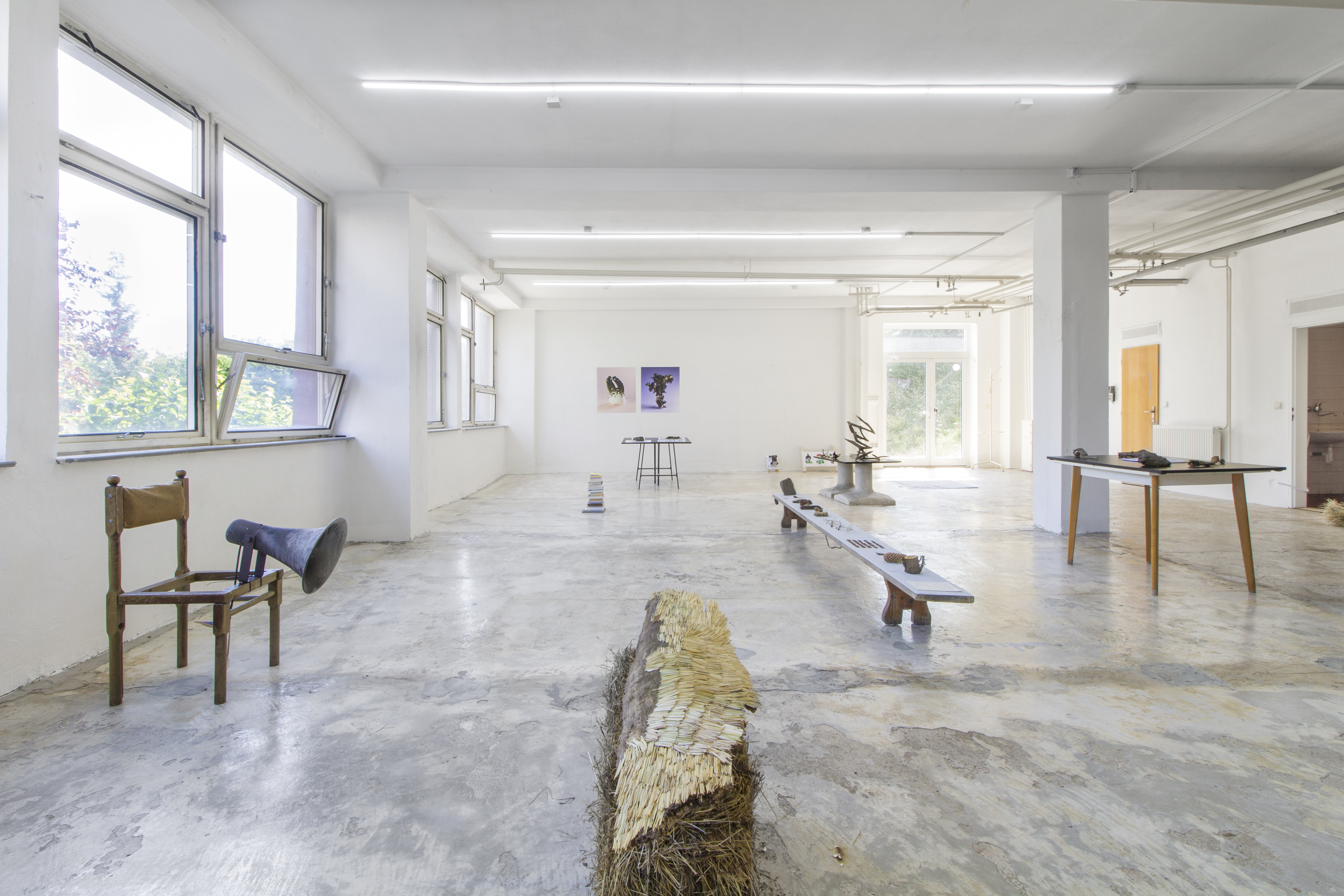
View of DEPOSIUM 2019 – IN BETWEEN exhibition at Banská St a nica, photo: De/posium archive.
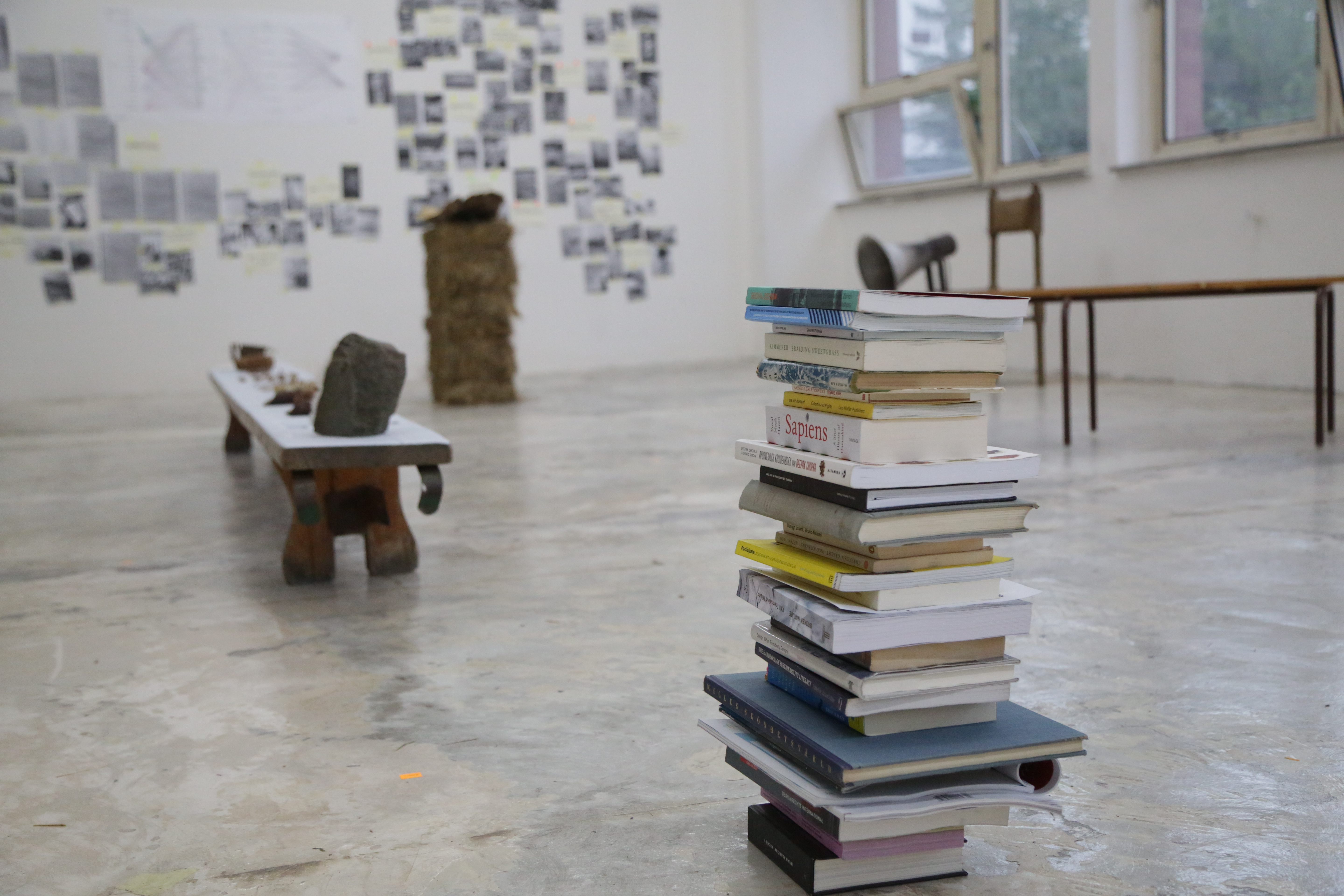
In order, Denisa Kollarová (SK, NL), performance, photo: De/posium archive.
The performance was inspired by the books brought by the Deposium participants to share their knowledge or discovery with others. The artist’s interest was to work with collective knowledge and its connections. The books were organised by their titles and their meaning during arranging sentences. A pile of books in motion turned the exhibition space into a sentence and this sentence was turned into a rhythm of moving human bodies.
The library is arranged according to the order of successive sentences that suggest the character of conversations that took or could take place within four days in Banská Štiavnica town during De/posium 2019.
The list of brought books 2019
Donald A. Schon: The Reflective Practitioner: How Professionals Think in Action
Social Design: Participation and Empowerment
Douglas Rushkoff: Present Schock
Erik Šimšík: Čabajka a iné údeniny (Hungarian Sausage and Other Cured Meats)
Ezio Mancini: Design, When Everybody designs
Bruce Sterling: Shaping Things
John Brockman: What to Think About Machines That Think
Christian Kracht – Ingo Niermann: Metan
Milan Adamčiak: Archív I (Archive I)
Bruno Munari: Design as Art
Barbara Predan (Ed.) XXII Triennale di Milano Catalogue: Broken Nature: Design Takes in Human Survival
Yuval Noah Harari: A Brief History of Humankind
Aran Stibbe (Ed.): The Handbook of Sustainability Literacy
Jun Ichiro Tanizaki: In Praise of Shadows
Beatriz Colomina, Mark Wigley: Are We Human?
Robin Wall Kimmerer: Braiding Sweetgrass
McMeekan: Grass to Milk
Helen Armstrong and Zvezdana Stojmirovic: Participate: Designing with User-Generated Content
Bruce Sterling: Shaping Things
Petra Černe Oven, Barbara Predan: Design Education: What Do You See? What Do You Do? Think About It? What Do You? Make of It?
Paola Antonelli, Ala Tannir (eds.): Broken Nature. XII Triennale di Milano.
Henrik Kornell: Milles Skonhet World
Joachim Kobuss, Alexander Bretz: Erfolgreich als Designer: Designrechte International Schützen und Managen
Mold magazine, The Future of Food No. 4: Designing for the Senses
Marlène Huissoud: Dear Obsession
Mit Technology Review, Vol 122 N°3
The AI-Powered Organization: Harvard Business Review
UN/SCHOOL UN/COOL UN/LEARN UN/THINK UN/SOLVE – DEPOSIUM 2018
D: The first year didn’t see any material outcomes, we spent much time discussing and putting down mental maps as a way of recording thoughts. What appealed to me most back then was the topic of education…
V: The traditional structure of education requires division into categories (fine art, applied art, art design, product design, social design). What’s left as a possibility and more to my liking is an educational system where you choose according to your interests rather than the medium you use (for example Material Futures…)
V: Education is obsolete and we want to change it… articulating it, even if only in the form of a dialogue, is very important in this space.
D: To strengthen the link with other disciplines – to have another perspective.
V: And what’s mostly needed is cooperation, peer-to-peer learning, discussions, active listening and asking questions.
D: Each participant had gone through a different school system and this experience itself was a forming factor for De/posium. For example, it was great to be in Scandinavia to see that their system is one of the options and that I am searching for the one which would be most natural for me. It’s up to me what I choose and add to it. I need to get out my comfort zone. And experiment. Allow myself a failure.
V: And to kick off, stimulate your thinking. Most of the time you don’t feel like expressing a relevant opinion about some issues. But you need to try.
D: This is where the educational potential of De/posium lies. Actually, it’s a pop-up format, with a possible long-term scope.
V: It can be one step that could shift you from school towards the system of thinking.

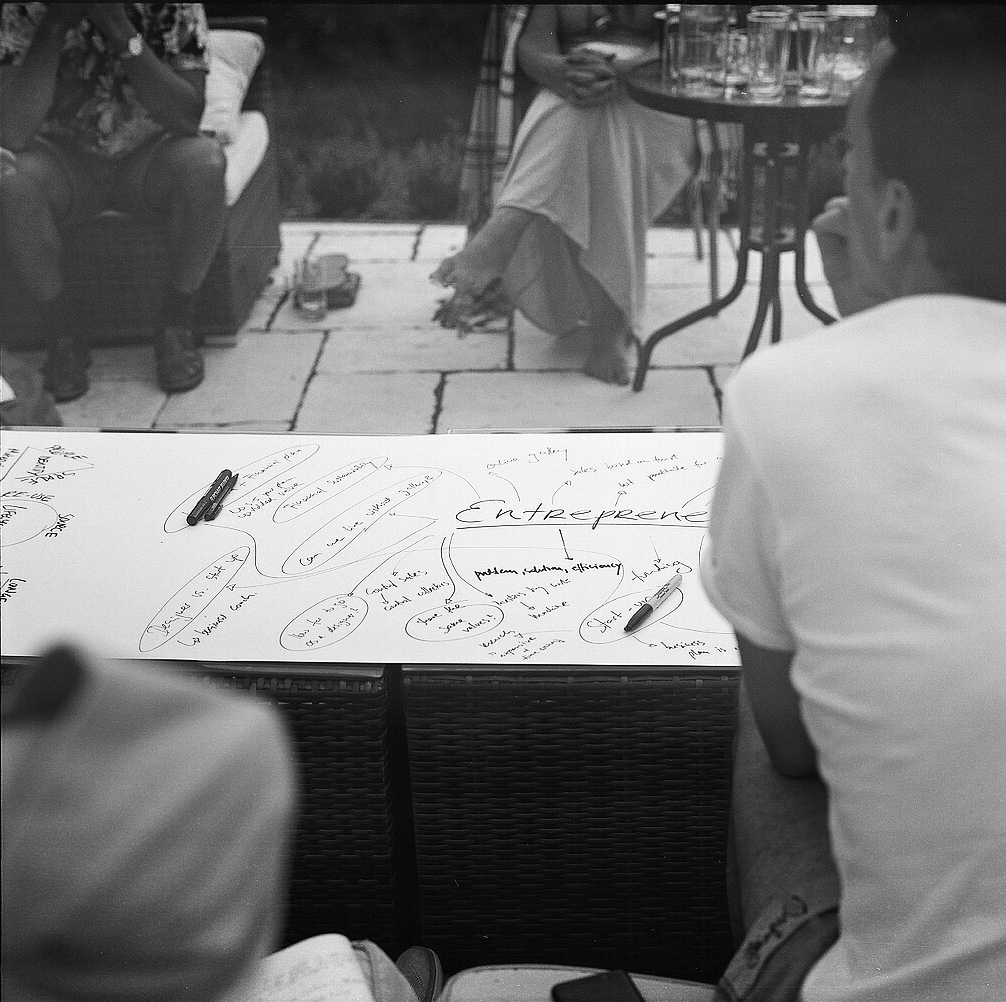
Atmosphere at Deposium 2018, Banská Štiavnica, photo: De/posium archive.
“The first year brought up some important questions about the contemporary role of design in the multidisciplinary discourse within the international context. Today’s creatives looking globally at the community and sustainability face the challenges of old models of knowledge, work and industry. Rather than just one solution, there are diverse perspectives that can make new approaches. De/posium provides time and space for discussion about complex design-related issues, bringing people from the international scene together and aiding to build a viable network across disciplines.”
Lilo Viehweg
UN/RAVEL – HOW IT ALL CAME ABOUT
V: At the very beginning, I was inspired by you telling me about your jewellery artists’ workshops/symposia where you as people from your field meet and create things. I came to realise there is no such thing for designers. Then we discussed it with Marlène and we told ourselves: why not make it this year (2018)?
D: So your idea about the workshop gave rise to De/posium.
V: I imagined it simply as a meeting somewhere that would not be an educational institution or an exhibition, but rather some space where you would have time for discussing an issue and create at the same time. There is an assigned theme or material and you’re supposed to make something. But the people invited from different backgrounds, such as Moritz Maria Karl from the architectural field, grasped the workshop as an all-day lecture, as a conference. Based on where they came from, they each had a different idea about the workshop/symposium. They were asking me what kind of paper they should prepare. Last year it was a symposium, but now it’s become a platform.
D: It’s funny that it was originally a symposium that made it much further. What I miss at an “ordinary” symposium is this continual discussion with people; we’re rather connected on the level of friendship. There is no such an organised, powerful room for discussion, you know, something like a time block dedicated to a certain issue…
V: It’s interesting, because I thought there was. (Laughing)
With Marlène and other people we met abroad at exhibitions, we touched upon issues we wanted to elaborate, but there was no space and time for it, as we had to fly back home. I miss that when you leave school, there is no-one to have a deeper conversation with about what you do. You know, to exchange knowledge and question your own relevancy of your work in dialogues with others. So this is also what we wanted to provide at the symposium. In two years, we’ve managed to put together quite a peculiar new community of people. Each of them has a different background, but, in this way, they can hold together.
D: Is it for designers? For creators? For whom?
V: We didn’t publish any open call. We turned to our friends in the first year. This year we called people based on their work. Whether it’s a designer, a scientist or an artist – it’s not only about new disciplines. We’d also like to connect different generations. Among this year’s participants was the artist Tue Greenfort. His opinions were radically different from those of the designers, and so this confrontation was quite serious.
D: Perhaps a framework (for example, design) is needed to see differences and contrasts, when someone comes from a different field.
V: Right, but I see design as a broad spectrum. In my eyes, you’re a designer as well. In my understanding it falls under the same umbrella. But, in principle, none of the participants feels to be defined just by one specific field, one type of a result or branch. We are connected by a common effort to have a positive impact, whether small or big.
D: At the same, there is no need to blur definitions. Then it’s not about making a highly diverse group (as each person represents diversity as such). It’s more about sharing a common space under this umbrella.
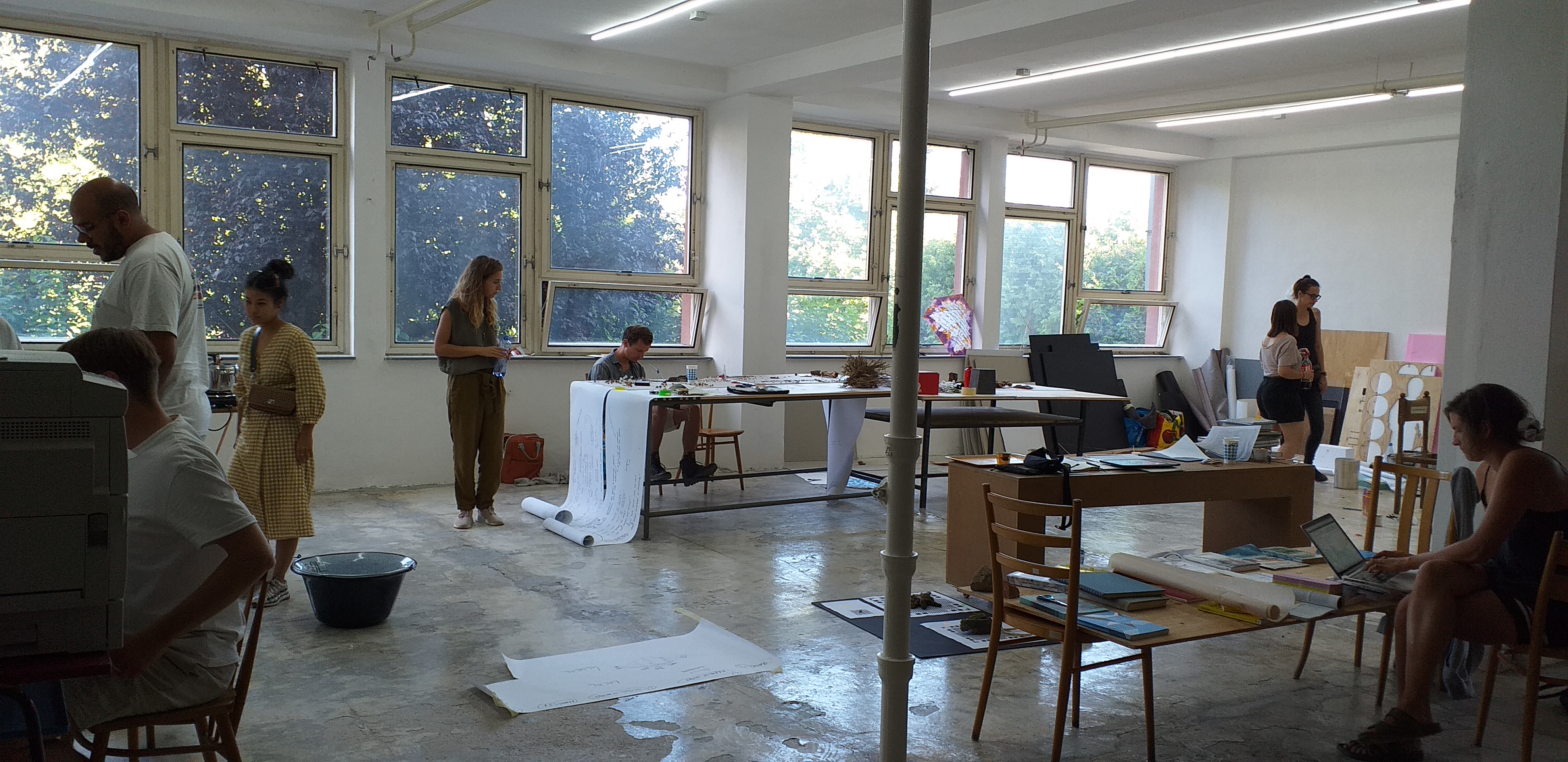
Creative cooperation at Banská St a nica, 2019, photo: Lilo Viehweg.
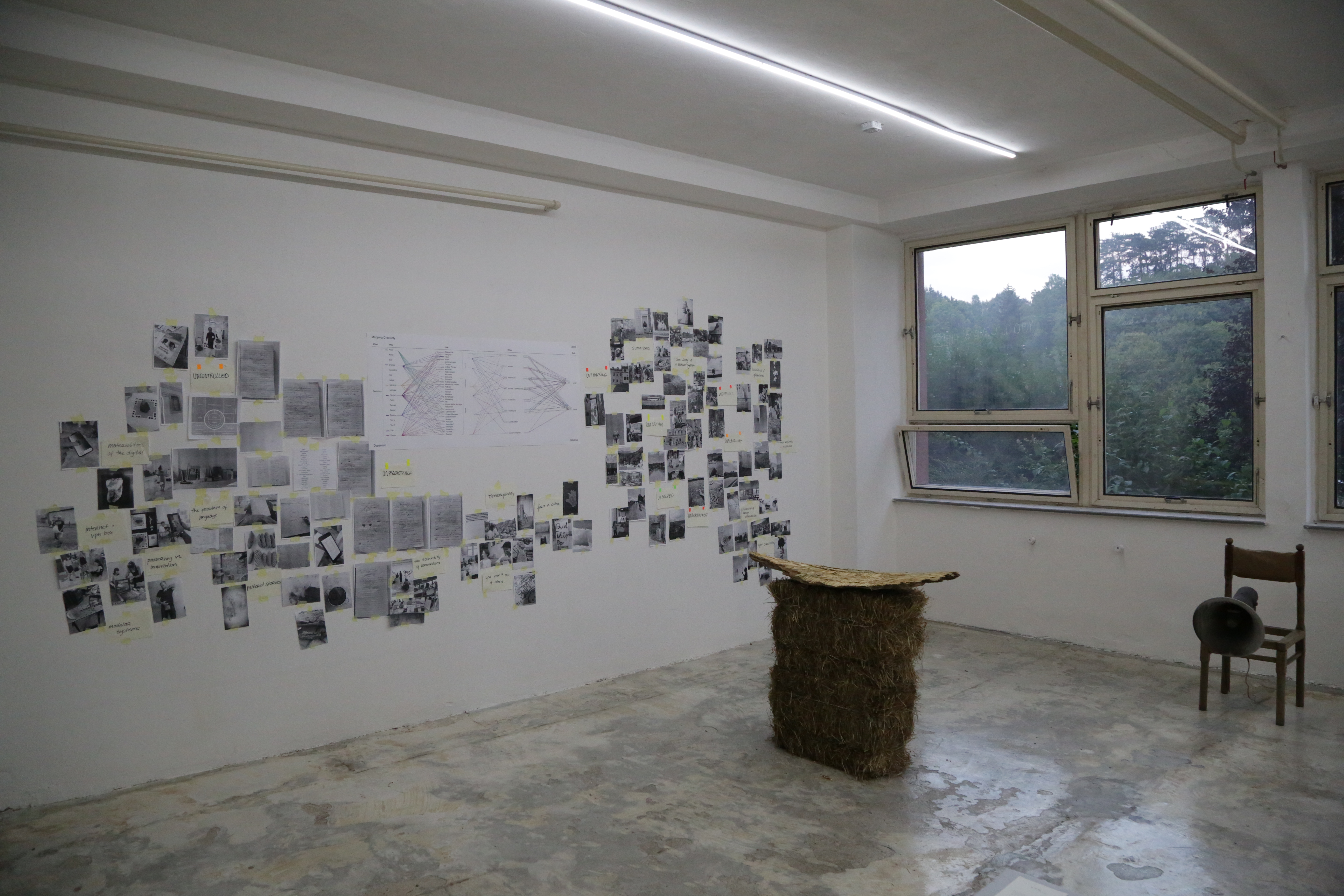
Collaborative interpretation of thoughts at the De/posium workshop 2019 in Banská Štiavnica, photo: Tomasz Wierzbicki.
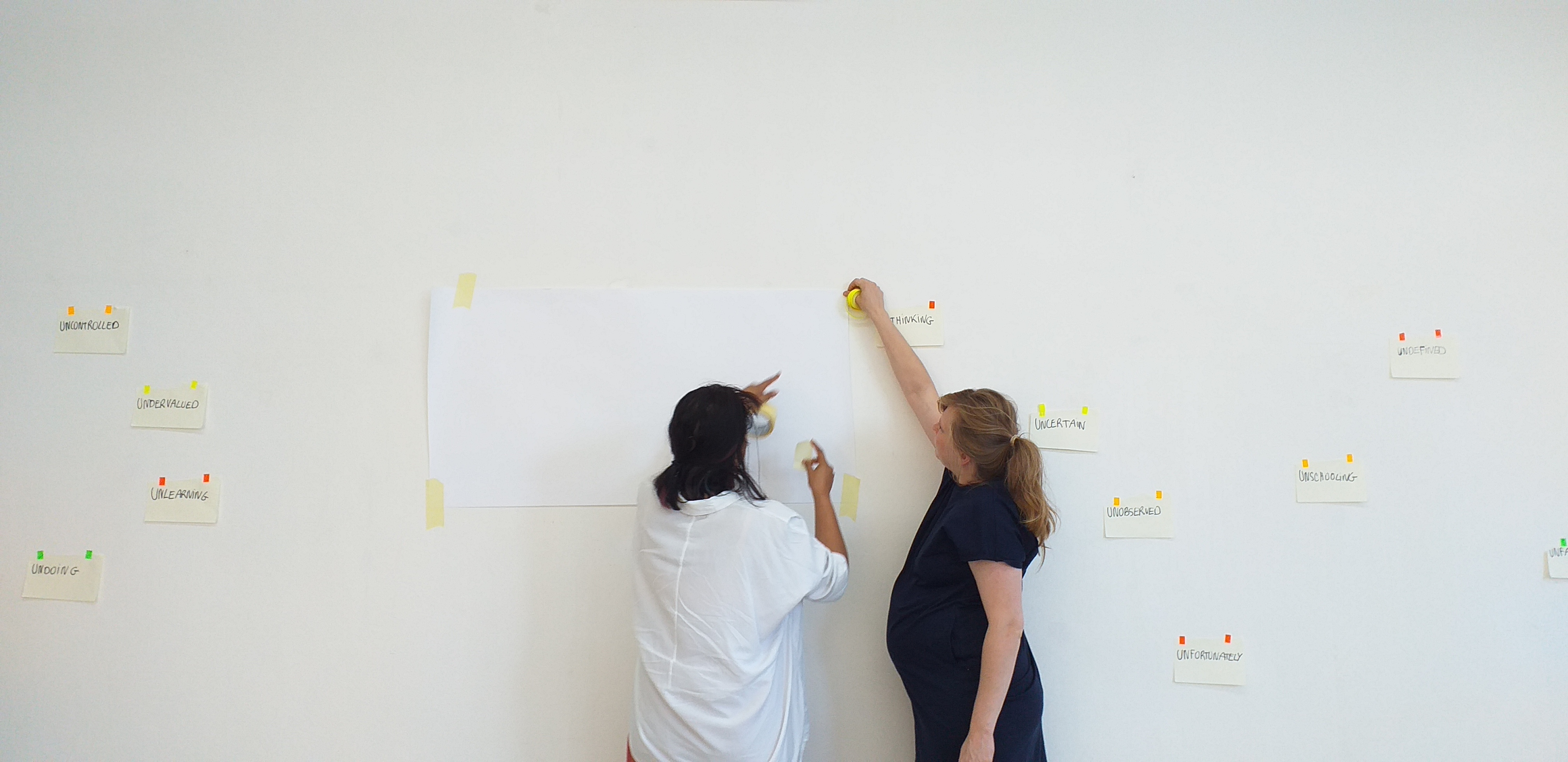
Collaborative interpretation of thoughts at the De/posium workshop 2019 in Banská Štiavnica, photo Lilo Viehweg.
The aim of the research wall was to navigate the visitors of the exhibition through four active days of creative process by means of asking questions, thinking and work. Eighteen international participants were gathering visual inspirations from the local environment, getting to know each other through common activities and discussing entrepreneurship, responsibility, sustainability and other issues related to creative work and life in the 21st century.
DE/SIGN DE/FINE DE/MONSTRATE DE/VELOPMENT
V: One of the topics we brought up in both years was entrepreneurship. It sounds like a very broad area, but it was crucial within De/posium. This discussion included an “honesty session” where everyone was supposed to admit how we really made money. What our work really entails. Whether it consists of gallery sales or some subsidised research programmes, educational activities, commercial projects or jobs that are completely unrelated to what we want to do.
It’s very inspirational and challenging to talk real about how we earn our living and learn how others do. Based on that, we can also draw a conclusion about the role of a designer today: who they are and who they can be.
MAP OF CREATIVITY
The map of creativity on the big screen sheds light on the complexity of work and roles of designers, artists or materials researchers today.
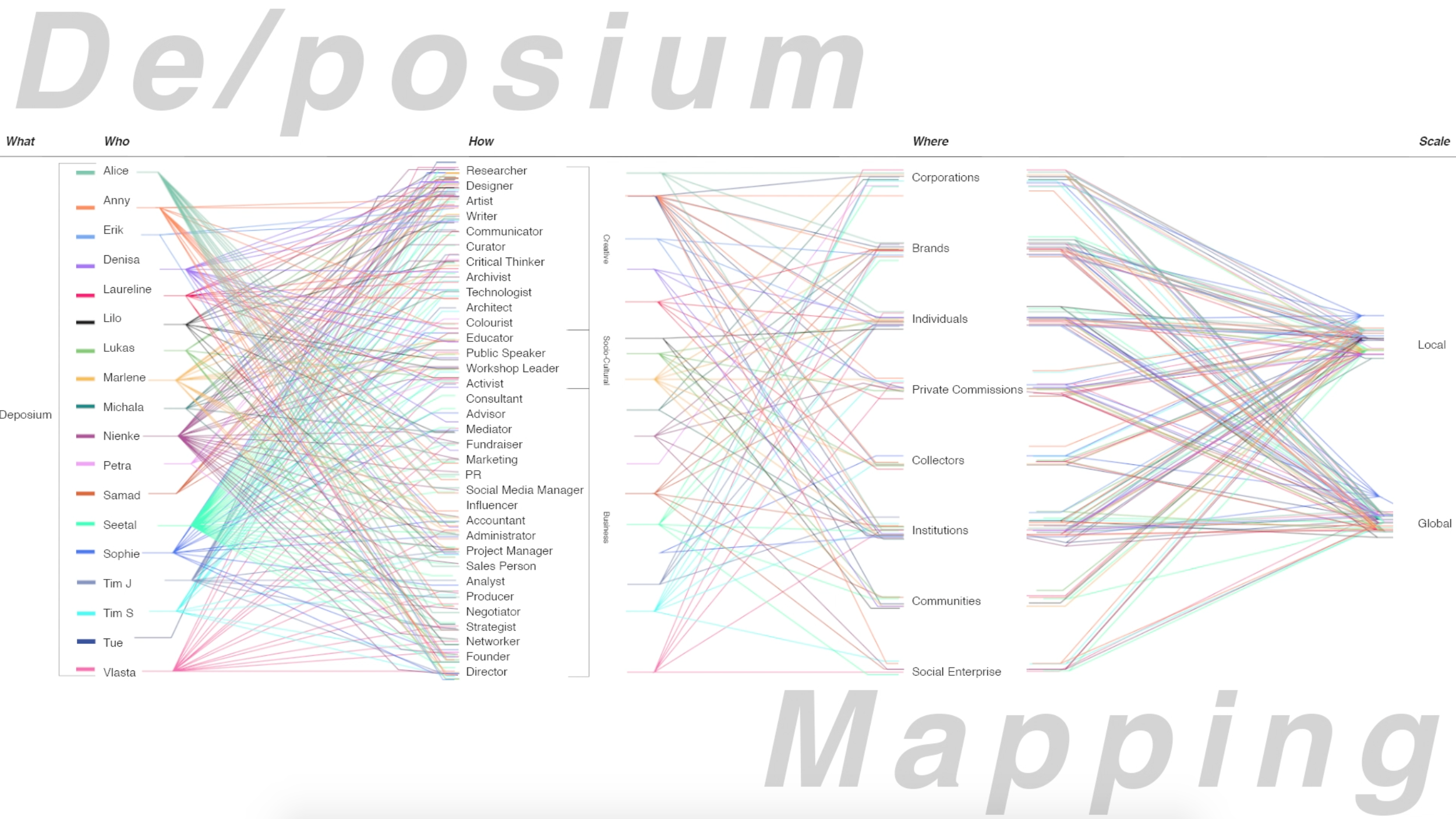
Educators
Practising designers are more and more frequent guests in academia – they hold workshops, talks and courses to bring their tangible experience into theory.
Researchers
Research allows designers to address challenges of our times meaningfully, embedding them into reality as deep as possible. Research-led design provides more options of financing and involves multidisciplinary approach.
Curators
Curators help designers get a better grasp of their thoughts, address new audiences, formulate new topics, start new conversations.
Consultants
A possibility to apply knowledge and skills to those branches of industry where they could have a positive impact.
Farmers
Transforming a traditional supply chain into a new one – designers search for new sources of material through recyclable by-products or they grow their own material themselves. Thus, they develop their own and sustainable production. Crowdfunding positive!
IN/BETWEEN IN/THE MOMENT IN/THE PLAYGROUND
D: What made you decide to hold De/posium in Banská Štiavnica?
V: It was the opportunity to leave town. I guess it’s a place where you can switch off better, longer and perceive not just the topic and discussion, but also people with whom you can spend day and night together. Simply take a break.
D: And go to a party at a lake, take an excursion to a mine, go for a walk to the forest, little tasks, long talks about our work until we get sunburnt. I view De/posium as an interesting malleable matter. It moves, it is fluid, it is forming and forming me. All the outcomes so far have been a constant search, letting a room for playfulness, spontaneity or unfinishedness. In some respect, it’s a safe zone of a playground where you play tag with other people. And it’s a great point of departure for realisation what and why I do something, who sees it, in which context and with which impact.
V: Exactly. I no longer remember who, but somebody said that feeling safe was precious. You don’t have to be afraid of confrontation or someone telling you that what you do is great just because you are a woman of colour or a woman. In this respect, you can be sure to be safe, as if you were talking to your family or friends, but on the professional level, because those who came rank in the top of their respective fields.
D: What’s interesting, the inner structure of the group forms along with the search for the from and character of outcomes (discussions, a workshop, an exhibition or a book we plan to publish). Should the group have a leadership, or is it a group without a leader, what principles apply? Everybody has their role or everybody does everything. How to build a platform based on sharing and collaborative principle?
I guess the point is not to make a format that aims to create something particular, but to create conditions where something can happen. To create an opportunity that is very open at the moment.
V: We weren’t really trying to create something mind-blowing. It gives the people some feeling of freedom, of playing or sorts. There is hardly any chance to have such a freedom in real life; you try to work to deadlines or you try to do it as best or good as it gets.
D: Design and art are closely bound in this respect. The same question is how to keep your thinking fresh, unbiased… When you don’t focus on the result – who will read, watch, share, buy or think about it. How can we show the value of process that can be more important than the final result?
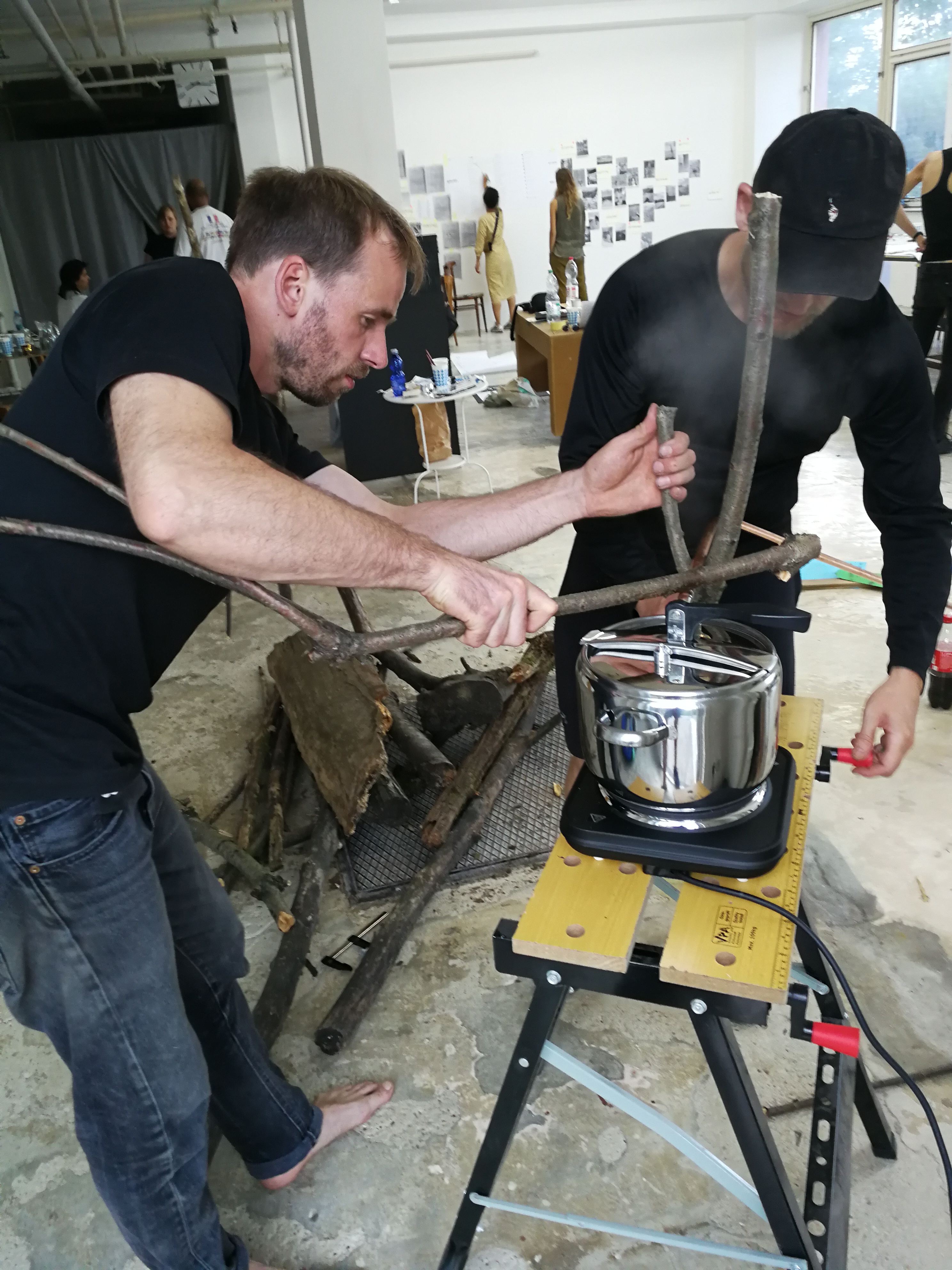
Distiller of essential oils, Tue Greenfort (DK, DE), Erik Šimšík (SK), 2019, photo: De/posium archive.
An adjusted pressure cooker, a copper pipe, a PVC pipe for hot water, offshoots of different conifers
Deposium essential oil
Country of Origin: Universe
Latin Name: Thuja (/ˈθjuːdʒə/ TUJA)
About the Oil: Deposium essential oil is steam distilled from the needles and twigs of thuja (cedar). Also known as “designers’ oil”; it has a brilliant, bright and uplifting aroma.
(Text modified from www.anandaessentialoils.com)
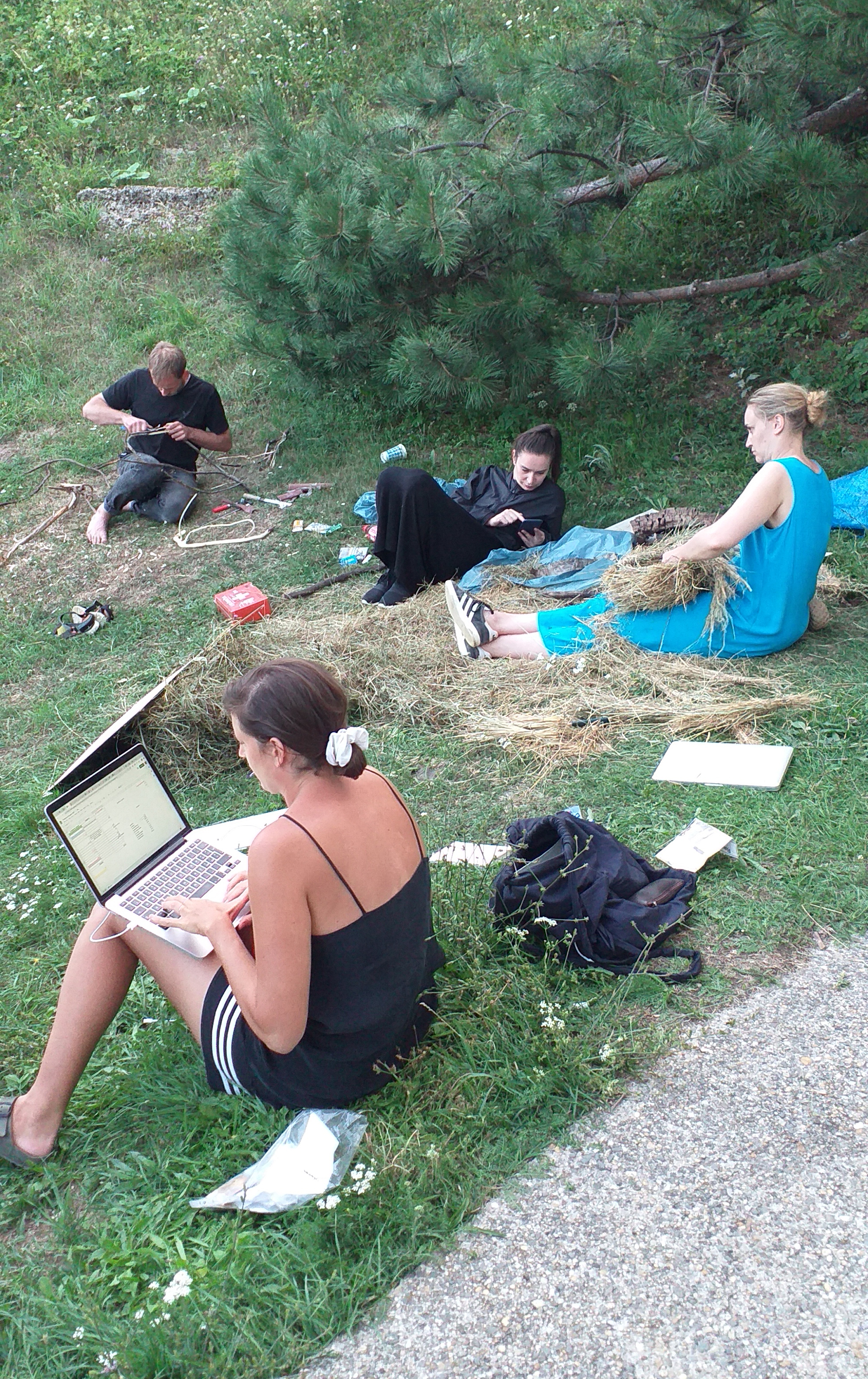
Silage, Sophie Rowley (NZ, DE) + De/posium 2019 participants, 2019, photo: De/posium archive.
Hay, wood
The Silage project refers to hay by revealing the yet undiscovered haptics and aesthetics of this otherwise common and humble resource. The process of experimentation led to making an object that shows the sleeker side of hay. Meticulous selection, arrangement and layering of stalks of hay on the wooden log gave rise to balanced surfaces. The aesthetics of this object resembles the accurately layered traditional thatched and wooden roofs typical for Banská Štiavnica of the present and the past.
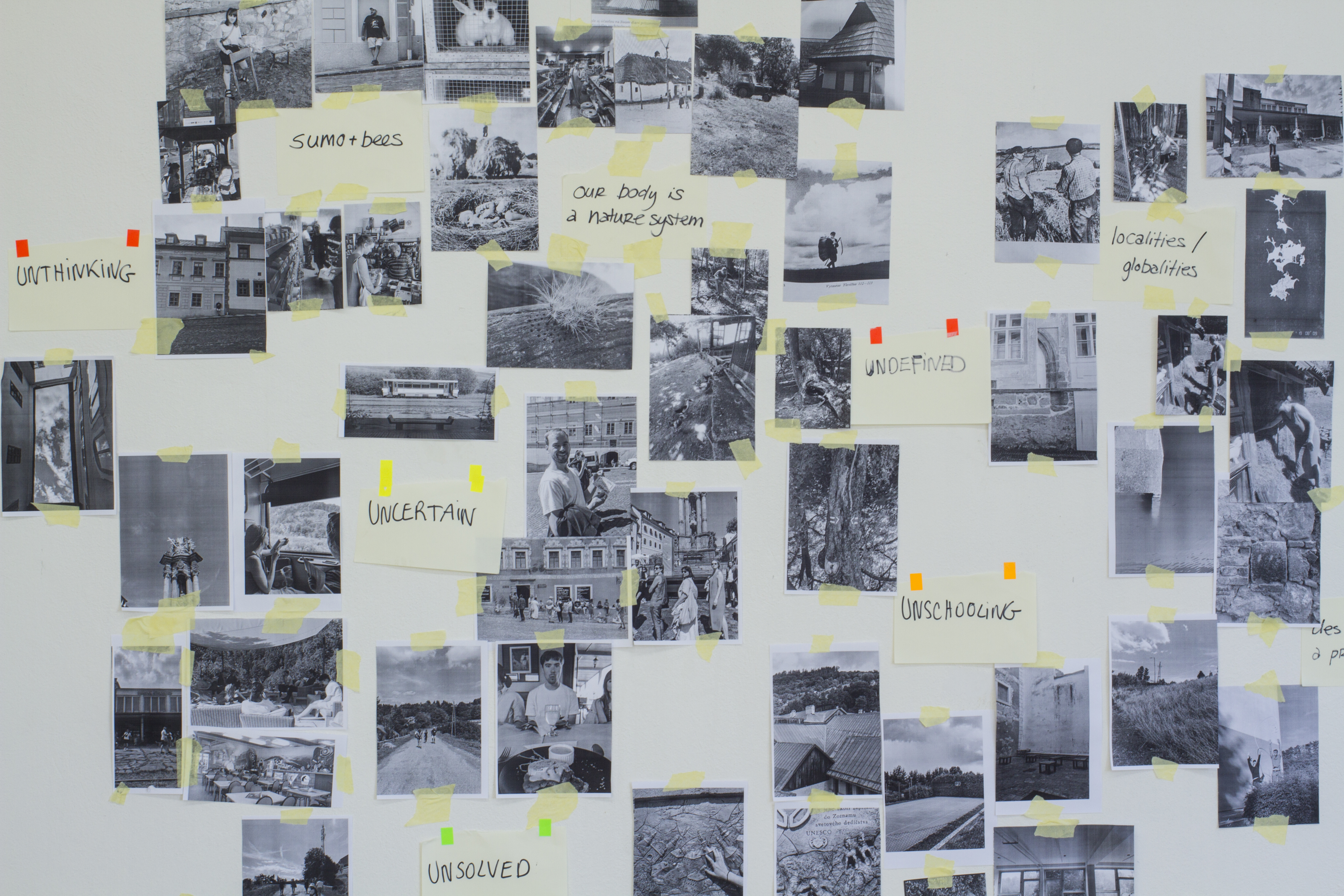
Photo: Leontína Berková.
Un – like contra – unsolved, uncertain, unclear… We try to come up with a solution, definition, options.
Unsolved-undefined-uncertain-unpredictable-uncontrolled. Unthinking too. Unschooling. Unfortunately?!
De – as decomposition that leads towards deconstructing (fragmentation), not towards enclosing. Between fields, definitions as well. Between practice and theory. Perception of oneself – of the world. Deconstruct-dematerialise-decolonise-decompose-detail
Across – how can we learn from one another and cross-cultural boundaries?
In-between – the point of departure is in-between. Incomplete, on the way, research, process. The STATE of Deposium.
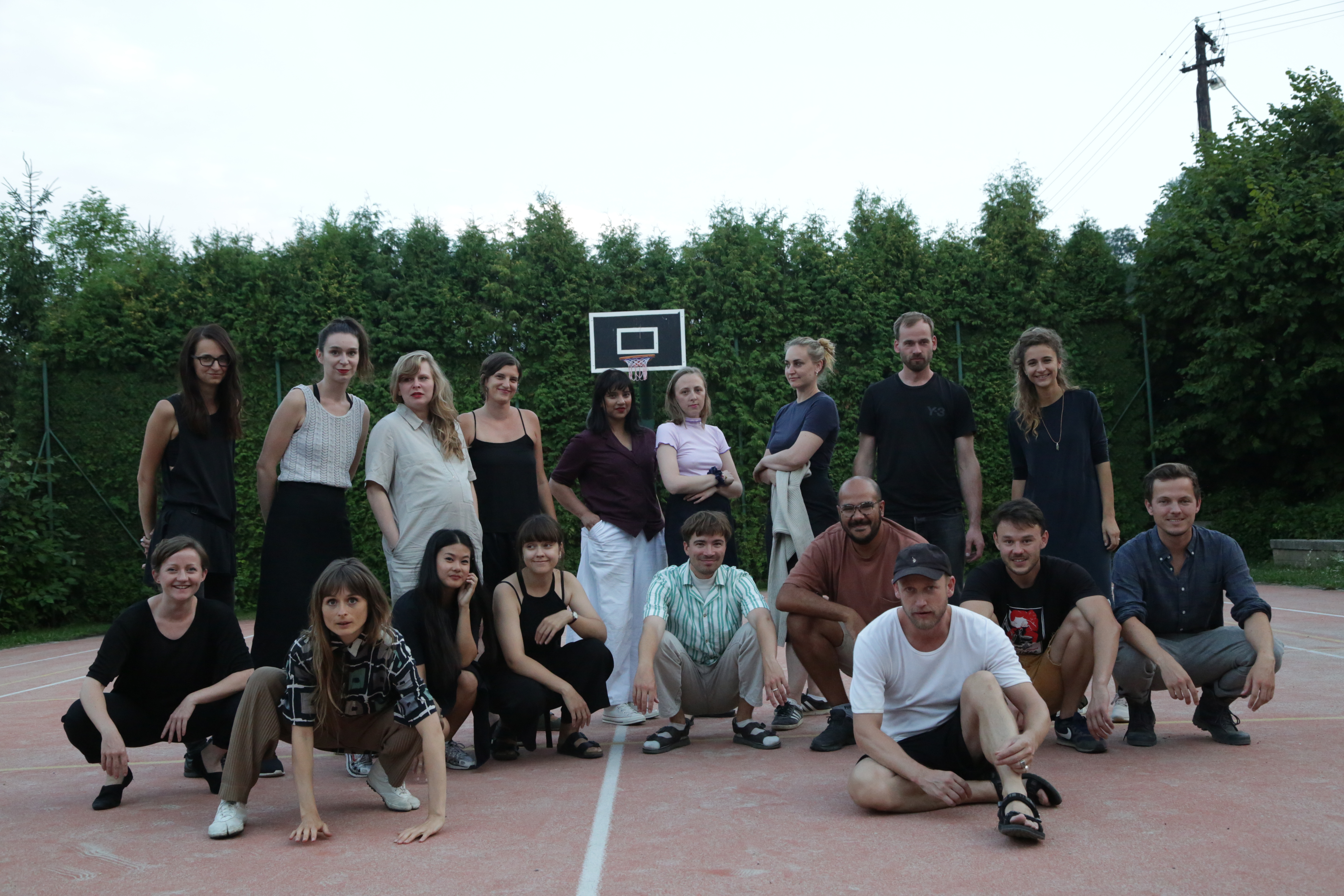
Group photo 2019, photo: Tomasz Wierzbicki.